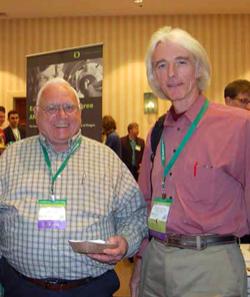Reflections on the Sigma Pi Sigma 2012 Congress
Fall
2012
Special Feature
Reflections on the Sigma Pi Sigma 2012 Congress
An Old-Timer's Perspective
By:Dwight E. Neuenschwander, Southern Nazarene University
 I have been privileged to attend every Quadrennial Congress of Sigma Pi Sigma since the first one of the "modern era," which took place in Dayton, OH, in 1992. What a ride it has been! I recall how the organizing committee of the 1996 Congress worried whether even 100 people would show up. Several members of that committee were present at the 2012 Congress, which drew more than 600 students and another 200 faculty members and alumni to Orlando, FL. Much has changed. Our hearts were glad.
I have been privileged to attend every Quadrennial Congress of Sigma Pi Sigma since the first one of the "modern era," which took place in Dayton, OH, in 1992. What a ride it has been! I recall how the organizing committee of the 1996 Congress worried whether even 100 people would show up. Several members of that committee were present at the 2012 Congress, which drew more than 600 students and another 200 faculty members and alumni to Orlando, FL. Much has changed. Our hearts were glad.
Sigma Pi Sigma has made a place for itself in the wider physics community. This year's congress overflowed with not only a passion for physics and a spirit of sheer joy, but also with a combination of activism and a willingness to serve the larger society. Yes, a good time was had by all. But more importantly, Sigma Pi Sigma, in partnership with the Society of Physics Students and other organizations, is now poised to make an indelible contribution to the culture of physics.
The proactive enthusiasm exhibited during the congress and the broad range of support it enjoyed from institutional cosponsors suggest that the physics community may be ready to encourage not only those who invest their lives in research, but also those who want to use a physics education to reduce poverty, ignorance, and despair. Critically placed in the landscape of physics society meetings, the congress provides an effective venue for a wider democracy in physics, by helping such people find one another. Let us keep that ball rolling!
Relationships hold communities together. For large communities to remain stable and authentically alive for long timescales, those relationships must be based on openness, diversity, and respect. Over the decades physicists have sometimes appeared to be rather exclusive. Agendas within the community deemed worthy of respect have often been quite narrow, dictated by esoteric problems in elite laboratories. But physics is too important and too powerful and too beautiful to be owned by a small number of experts talking mostly with each other. The Sigma Pi Sigma Congresses can revitalize how the physics community sees itself.
Most of the congress attendees were young. The youthful exuberance that filled this congress revitalized us old-timers, reminding us of the values and passions that drew us into physics in the first place. Conversely, the advice and wisdom of senior physicists was clearly valued and appreciated by the young. It was heart-warming to see the likes of Jocelyn Bell Burnell and John Mather surrounded by crowds of young people. Freeman Dyson was particularly amazing. Eighty-eight years old, he stood patiently for three days, facing long lines of people waiting to shake his hand, turning no one away. He was essentially the last congress participant to leave on Saturday night.
A workshop coordinated by David Mosher, director of the National Security Division of the Congressional Budget Office, tested the physics students with a model exercise that bridged science and society. He asked groups to decide how to cut more than $80 billion of spending from federally funded science programs. As you know, physics students are always up to a challenge! But the sobering exercise made everyone realize the difficulty of such a task, ponder the consequences of different choices, and consider how science interacts with politics—which can be just as complex as physics itself.
Revolutions are almost always started by young people who eagerly want to change the world. Those with physics-trained habits of mind are especially well equipped to enact those changes responsibly and sensibly. Both the physics enterprise and society at large would be well served by incorporating those who have a passion for physics and are willing to strive earnestly for competence. That is where Sigma Pi Sigma and the Society of Physics Students come in. As in baseball or in music, physics will always have its legendary superstars. But physics needs a deep bench, a broad base of informed appreciators.
The 2012 Congress showed how young people who carry this tremendous reservoir of enthusiasm, talent, willingness to serve, and passion for physics—all spiced with a joyful love of life—can find one another and work creatively in the interest of improving the well-being of civilization and life on our planet. //
